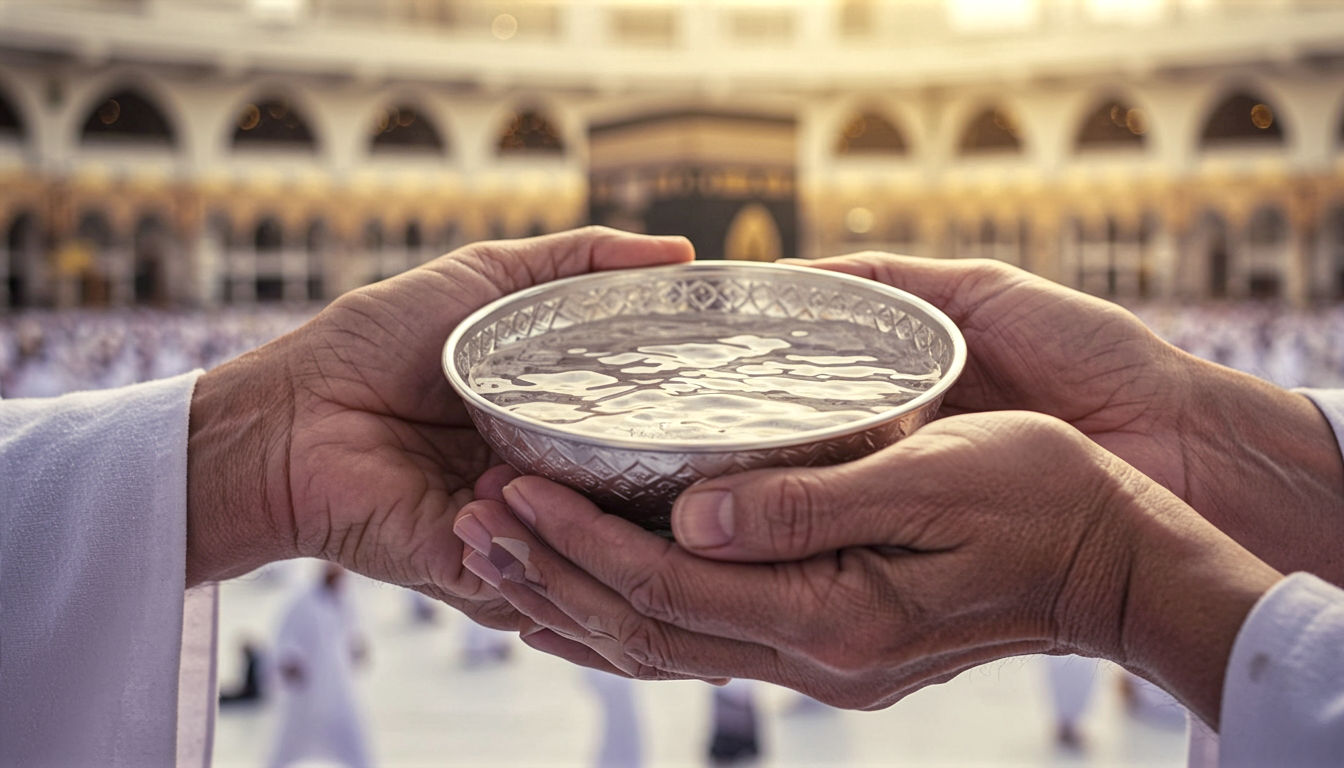The Holy Grail of Water: The Astonishing Story of Zamzam
The definitive guide to Zamzam water. From its sacred origins in Mecca to its unique properties and significance today.

This post may contain affiliate links. If you make a purchase through these links, we may earn a commission at no additional cost to you.
Deep beneath the desert sands of Mecca, in a place bustling with millions of pilgrims each year, lies a small well that has been gushing for thousands of years. It’s not just any well, and this isn’t just any water. This is the Well of Zamzam, and the water it produces is considered by over a billion Muslims to be the holiest on Earth.
For centuries, its story has been passed down through generations—a tale of a desperate mother, a crying baby, and a miraculous spring that appeared in the middle of nowhere. But what exactly is Zamzam water? Is it just a legend, or is there more to it? Why do people travel thousands ofmiles, from cities like London, Manchester, and Birmingham, just to bring back a small bottle of it?
This is the complete story of Zamzam water. We’ll dive into its incredible history, explore its deep spiritual meaning for Muslims, and look at what scientists have discovered about its unique properties. We’ll also cover the huge operation that gets this sacred water from a single well in Saudi Arabia to millions of people around the world, including right here in the UK. Whether you’ve heard of it before or this is all new to you, get ready to discover why this is no ordinary water.
What is Zamzam Water? The Basics Explained
At its heart, Zamzam water is sacred water that comes from the Well of Zamzam, located just a few metres east of the Kaaba in the Grand Mosque of Mecca, Saudi Arabia. For Muslims, it’s not simply H₂O; it’s a blessed substance with a rich history tied to some of the most important figures in Islam, including the Prophet Abraham (Ibrahim in Arabic), his wife Hagar (Hajar), and their infant son, Ishmael (Isma’il).
Think of it like this: for Christians, water from the River Jordan holds a special significance because it’s where Jesus was baptised. For Muslims, Zamzam water holds a similar, if not greater, spiritual weight. It’s considered a gift from God (Allah), a source of healing, and a physical link to a foundational story of faith and perseverance.
Pilgrims who perform the Hajj or Umrah—the major and minor Islamic pilgrimages to Mecca—make it a point to drink Zamzam water and bring it home for family and friends. It’s a central part of the pilgrimage experience, a tradition that has continued unbroken for thousands of years.
Where Does the Name ‘Zamzam’ Come From?
The name “Zamzam” itself is fascinating. It’s believed to come from the Arabic phrase Zome Zome, which means “stop flowing!” This is what Hagar is said to have cried out as she tried to contain the gushing spring with her hands and sand. She was worried the precious water would run out into the desert and be lost, so she was essentially telling it to “stop! stop!” and form a well. The name captures that moment of miraculous discovery and the attempt to preserve a divine gift.
The Miraculous Origins: A Story of Faith and Survival
To truly understand Zamzam, you have to know its origin story. It’s a powerful tale of a mother’s love and unwavering faith, set in a harsh and unforgiving landscape.
According to Islamic tradition, the story begins with the Prophet Abraham. Following God’s command, he led his wife, Hagar, and their baby son, Ishmael, to a barren, empty valley in the Arabian desert. This valley, known as Bakkah, had no water, no plants, and no people. It was, for all intents and purposes, the middle of nowhere.
After leaving them with only a small bag of dates and a leather water-skin, Abraham turned to leave. A worried Hagar ran after him, asking, “O Ibrahim, where are you going, leaving us in this valley in which there is no person whose company we may enjoy, nor is there anything?”
Abraham didn’t look back. She asked him again, but he remained silent. Finally, she asked the most important question: “Has Allah commanded you to do so?”
He replied, “Yes.”
Her response was one of complete trust. “Then He will not neglect us,” she said, and returned to her baby.
The Desperate Search for Water
As the days passed, the water ran out. Ishmael, tormented by thirst, began to cry. Hagar couldn’t bear to see her son suffer. Driven by desperation, she started searching for water.
She ran to the nearest hill, a small rocky outcrop called Safa, to see if she could spot any travellers or a source of water. Seeing nothing, she ran across the valley to another hill, Marwah. She ran back and forth between the two hills seven times in the blistering heat. This desperate act, known as the Sa’i, is re-enacted by every single pilgrim during Hajj and Umrah today. It symbolises a mother’s struggle and her absolute reliance on God.
After her seventh run, as she stood on Marwah, she heard a voice. She called out, and the voice replied. It was the Angel Gabriel (Jibril). He stood near the crying baby Ishmael. With a strike of his wing or foot, the angel hit the ground, and water miraculously began to bubble up from the sand.
This was the spring of Zamzam. Overjoyed, Hagar rushed to it and began to build a small basin of sand around it to stop the water from flowing away, shouting “Zome Zome!” And the well was born. They were saved. Soon, birds began to circle overhead, a sign of water in the desert. Passing caravans noticed the birds and came to investigate. They asked Hagar for permission to drink from the water, and she agreed, on the condition that the well would always belong to her and her descendants. A community grew, and this barren valley would eventually become the bustling city of Mecca.
The Spiritual Significance: Why Zamzam is More Than Just Water
For Muslims, Zamzam water is packed with spiritual meaning and blessings. It’s not just something you drink to quench your thirst; it’s an act of worship and a way to connect with God.
The Prophet Muhammad is reported to have said, “The best water on the face of the earth is the water of Zamzam; it is a kind of food and a healing from sickness.” This belief is central to why it’s so cherished.
Here’s a breakdown of its spiritual importance:
- A Symbol of God’s Mercy: The story of Zamzam is a powerful reminder that God provides, even in the most hopeless situations. Hagar was alone in a barren desert, but her faith was rewarded. Drinking Zamzam reminds believers of this divine mercy.
- A Source of Healing (Shifa): Muslims believe Zamzam water has healing properties. People drink it hoping to cure illnesses, both physical and spiritual. While this is a matter of faith, countless personal stories and anecdotes from believers attest to its perceived healing effects. It’s common for Muslims to give Zamzam water to sick relatives.
- A Form of Sustenance: Another tradition says that Zamzam can provide sustenance. The Prophet Muhammad reportedly said, “The water of Zamzam is for whatever it is drunk for.” This means that if you drink it seeking knowledge, healing, or even to satisfy hunger, your intention matters. For centuries, there have been accounts of scholars and pious individuals surviving for long periods on nothing but Zamzam water.
- Used in Sacred Rituals: Zamzam water is used in important Islamic rituals. For instance, it’s reported that the Angel Gabriel washed the heart of the Prophet Muhammad with Zamzam water when he was a child, preparing him for prophethood. The bodies of the deceased are also sometimes washed with Zamzam water before burial as a final blessing.
Drinking Zamzam water also comes with its own etiquette. It is recommended to face the Kaaba, say Bismillah (“In the name of God”), and drink it in three sips, sitting down if possible. Upon finishing, one says Alhamdulillah (“Praise be to God”). Many also make a personal prayer or supplication (du’a) before drinking, believing it’s a time when prayers are more likely to be answered.
What’s Actually in Zamzam Water? A Look at the Science
For thousands of years, the well of Zamzam has been providing water without ever running dry. This alone is remarkable. But what does science say about the water itself? Numerous studies have been conducted over the years, and they’ve revealed some interesting characteristics.
It’s important to approach this topic with balance. For believers, the blessings of Zamzam are a matter of faith, not scientific proof. For scientists, the water is a natural phenomenon worth studying.
The Unique Mineral Composition
The Well of Zamzam is fed by groundwater that runs through the rock layers deep beneath the valley. Scientific analysis has shown that Zamzam water has a distinct and consistent mineral composition.
- Higher Mineral Content: Compared to regular bottled drinking water, Zamzam water is richer in certain minerals, particularly calcium and magnesium. These are essential minerals for the body, contributing to bone health and muscle function. This higher mineral concentration gives it a unique, slightly heavier taste that many people can instantly recognise.
- Naturally Alkaline: Zamzam water is naturally alkaline, with a pH level typically ranging from 7.5 to 7.7. For comparison, pure neutral water has a pH of 7. Most tap water in the UK has a pH between 6.5 and 8.5, so it’s within a normal range, but Zamzam’s alkalinity is a consistent feature. Some health advocates claim alkaline water has benefits, though this is debated in the wider scientific community.
- Rich in Fluoride: It contains higher levels of fluoride than most other water sources. Fluoride is known for its benefits in preventing tooth decay, and its presence in the water is considered a natural blessing.
- Free from Contaminants: Despite being in use for millennia and located in the centre of a massive city, studies consistently show the water is free from harmful bacteria and biological contaminants. It remains pure and drinkable straight from the source. This is partly due to the geology of the area and the stringent measures now in place to protect the well.
One of the most common claims you might hear online is that Zamzam water has a “perfect structure” or unique energy that can be seen in crystals. This idea was popularised by the late Japanese author Masaru Emoto, who claimed that water crystals changed shape in response to positive or negative words. However, his work is widely considered pseudoscience by the scientific community and has not been replicated in controlled studies.
So, while science can confirm its unique mineral profile and purity, the spiritual claims of healing and blessings remain in the realm of faith. For Muslims, these scientific details are interesting but secondary to the water’s divine origin.
From Ancient Well to Modern Marvel: Managing Zamzam Today
For most of its history, the Well of Zamzam was a simple, stone-lined hole in the ground. People would lower buckets to draw water. But with millions of pilgrims visiting Mecca every year, this traditional method was no longer enough.
Today, the management of the Zamzam well is a massive, high-tech operation run by the Saudi government. The well itself is now housed in a basement room, sealed off from the public to protect its purity.
Here’s how it works now:
- Pumping and Sterilisation: Giant electric pumps draw water from the well 24/7. The water is pumped into a holding tank where it is treated with ultraviolet (UV) light. This is a precautionary measure to kill any potential bacteria without adding any chemicals, preserving the water’s natural composition.
- Distribution Network: From there, the water is channelled through a huge network of stainless-steel pipes to various distribution points. Thousands of cooled water dispensers are located throughout the Grand Mosque in Mecca and the Prophet’s Mosque in Medina (over 200 miles away), allowing pilgrims to drink fresh, cool Zamzam water whenever they wish.
- The King Abdullah Zamzam Water Project: To meet the enormous demand from pilgrims wanting to take water home, the Saudi government launched a massive bottling plant in 2010. The King Abdullah bin Abdulaziz Zamzam Water Project is a state-of-the-art facility that can produce millions of bottles a day. The process is fully automated to ensure hygiene. The bottles, typically 5 or 10 litres, are filled, sealed, and packaged for pilgrims to purchase.
This enormous infrastructure project ensures that this ancient well can continue to provide for the millions who seek its blessings, combining modern technology with sacred tradition.
Getting Zamzam Water in the UK: Rules, Realities, and Risks
For the hundreds of thousands of British Muslims who perform Hajj or Umrah each year, bringing Zamzam water home is a vital part of their journey. It’s a precious gift for loved ones who couldn’t make the trip.
How it Gets Here
Traditionally, pilgrims would fill their own containers and check them in as luggage. However, to manage logistics and ensure safety, airlines now have strict rules.
- Official Allowances: Most airlines flying from Saudi Arabia have an agreement to allow each pilgrim returning from Hajj or Umrah to check in one pre-packaged, factory-sealed 5-litre bottle of Zamzam water, often free of charge. This is usually bought at the airport in Jeddah or Medina.
- Customs in the UK: Bringing Zamzam water into the UK for personal use is generally straightforward. The UK border authorities treat it as bottled water. As long as it’s for personal consumption and properly sealed, there are usually no issues.
The Black Market and Fake Zamzam
Because of the high demand, a black market for Zamzam water has unfortunately emerged, both online and in some local shops in the UK. Unscrupulous sellers might sell ordinary tap water, or diluted Zamzam water, in bottles that look official.
Here’s why buying from unofficial sources is risky:
- Authenticity: There is no guarantee you are getting genuine Zamzam water.
- Safety: The water could be contaminated. Official Zamzam water is bottled under sterile conditions, but water from an unknown source could be unsafe to drink.
- Exploitation: These sellers are exploiting people’s faith for financial gain.
Saudi authorities have repeatedly warned against this. The only officially sanctioned Zamzam water for sale is from the King Abdullah project, and it is not officially exported for commercial resale. Any “Zamzam” water you see for sale in a UK shop or online is almost certainly not from the official source. The safest and most reliable way to obtain genuine Zamzam water is to receive it as a gift from someone returning from pilgrimage.
Zamzam Water: A Timeless Symbol
The story of Zamzam is about much more than a well. It’s a story that has echoed through millennia, touching the lives of billions. It’s a powerful symbol of a mother’s love, of divine providence, and of a faith that can turn a barren desert into a thriving metropolis.
From the desperate footsteps of Hagar running between Safa and Marwah to the high-tech bottling plant of today, the journey of Zamzam water is a blend of the ancient and the modern. It connects a British Muslim in Glasgow to a pilgrim in Mecca and to the very foundations of their faith.
Whether viewed through the lens of faith as a miraculous cure or through the lens of science as a mineral-rich natural spring, one thing is certain: Zamzam is no ordinary water. It is a living piece of history, a source of spiritual nourishment, and a testament to the enduring power of a simple prayer answered in the most remarkable way.
Further Reading
For those interested in exploring this topic further, here are some highly respected resources:
- Saudi Geological Survey: Provides scientific information and data on the Well of Zamzam.
- The British Museum: Offers context on the Hajj pilgrimage and Islamic history.






